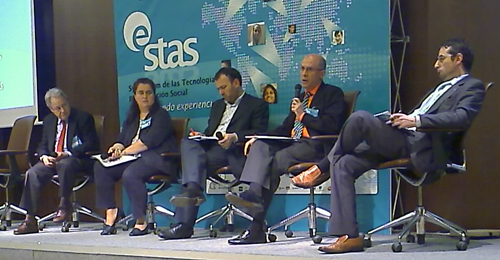e-STAS is a Symposium about the Technologies for the Social Action, with an international and multi-stakeholder nature, where all the agents implicated in the development and implementation of the ICT (NGO’s, Local authorities, Universities, Companies and Media) are appointed in an aim to promote, foster and adapt the use of the ICT for the social action.
Here come my notes for session IV. (notes at random, grouped by speaker, but not necessarily in chronological order)

Left to right: Francisco Ortiz Chaparro, Belén Perales, Javier Estévez (moderator), Javier de la Nava Trinidad, José Manuel García Prieto
Belén Perales, IBM
Why corporate volunteering? Employees demand it and their satisfaction, engagement, etc. does increase with nonprofit or development projects engagement. And this does benefit the firms beyond profit.
Francisco Ortiz Chaparro, AHCIET
Public-private partnerships are an important key for the development of the Information Society.
Big firms are kidnapped by their highest directors, that apply for themselves retribution policies that generate huge inequalities within the firm. This is a barrier for both the credibility of the firm as socially committed and the engagement of the rest (the basis) of the employees. Shareholders should enforce their rights to achieve more transparency and accountability of the behavior of such boards of directors, for both economic management and social responsibility reasons.
There is a good amount of nonprofits and projects that are created ad hoc as (public) grant raisers. Nonprofits should change their minds and think on project designs that could include firms and even benefit them, so through a mutual benefit, partnerships between the civil society and enterprises could arise. And, at the same time, the project will gain sustainability.
Javier de la Nava Trinidad, BBVA
The five groups of stakeholders: shareholders, providers, customers, employees, the society at large. And it is not only the customers that a firm has to keep content, but the whole panoply of stakeholders.
There is an increasing need for employers to have their employees engaged and identified with the firm, to be satisfied in their workplaces.
José Manuel García Prieto, SUN Microsystems
It’s true that telecoms benefit from more ICT use, hence why fostering its use in their corporate strategy.
There is not a single model of cooperation between nonprofits and firms, but normally the model is that firms give away the know how, their knowledge, their human capital, etc.
e-Stas 2008, Symposium on Technologies for Social Action (2008)
If you need to cite this article in a formal way (i.e. for bibliographical purposes) I dare suggest:
Peña-López, I. (2008) “e-STAS 2008 (IV). Round Table: The role of Enterprises to achieve the Socio-Digital Inclusion” In ICTlogy,
#55, April 2008. Barcelona: ICTlogy.
Retrieved month dd, yyyy from
https://ictlogy.net/review/?p=709
Previous post: e-STAS 2008 (III). Round Table: The role of the Public Sector to achieve the Socio-Digital Inclusion
Next post: e-STAS 2008 (V). Workshop: web programmes and content
 RSS feed for comments on this post.
TrackBack URI
RSS feed for comments on this post.
TrackBack URI

